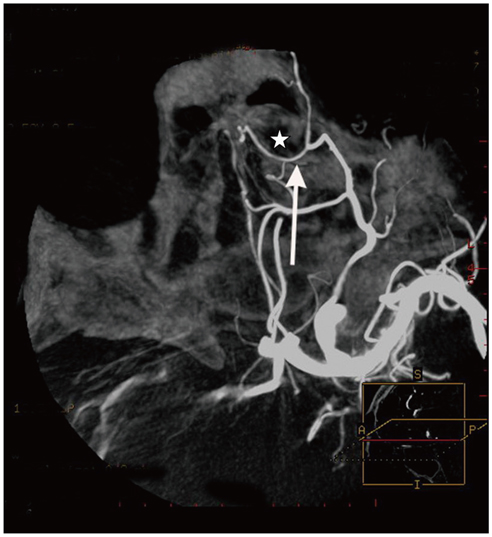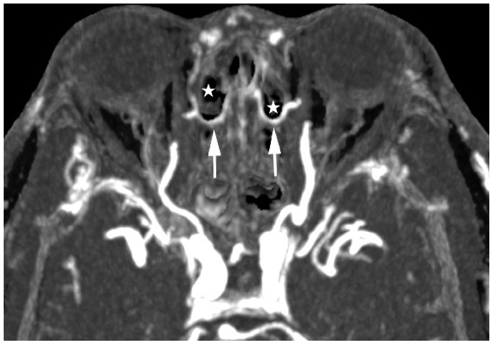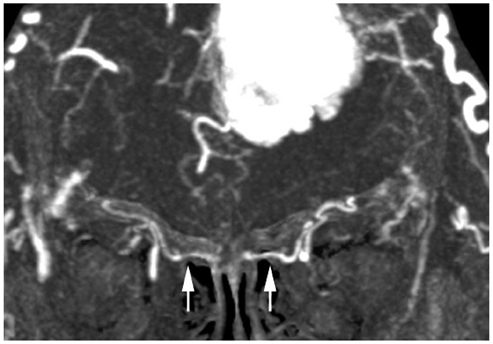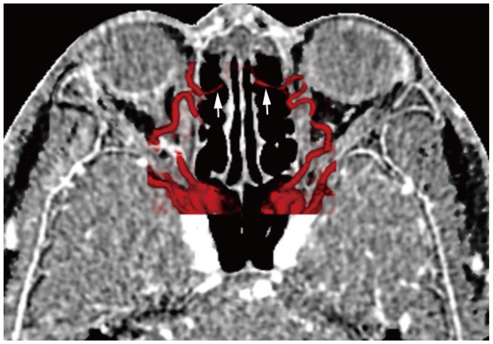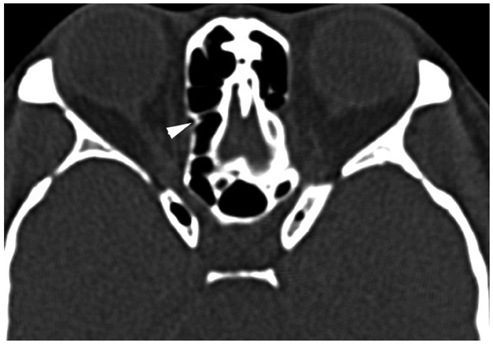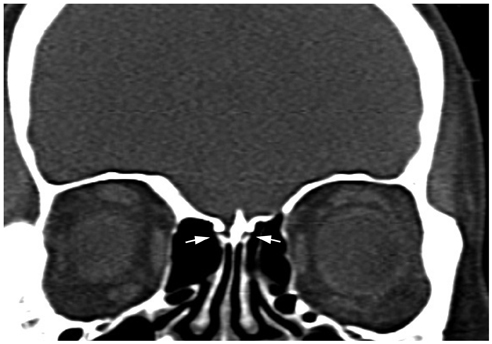Korean J Radiol.
2012 Dec;13(6):667-673. 10.3348/kjr.2012.13.6.667.
Evaluation of Anterior Ethmoidal Artery by 320-Slice CT Angiography with Comparison to Three-Dimensional Spin Digital Subtraction Angiography: Initial Experiences
- Affiliations
-
- 1Department of Medical Imaging, Jinan Military General Hospital, Jinan 250031, China. cjrsungang@163.com
- 2Department of Radiology, University of Illinois College of Medicine, IL 60612, USA.
- KMID: 1397496
- DOI: http://doi.org/10.3348/kjr.2012.13.6.667
Abstract
OBJECTIVE
To explore the usefulness of 320-slice CT angiography (CTA) for evaluating the course of the anterior ethmoidal artery (AEA) and its relationship with adjacent structures by using three-dimensional (3D) spin digital subtraction angiography (DSA) as standard reference.
MATERIALS AND METHODS
From December 2008 to December 2010, 32 patients with cerebrovascular disease, who underwent both cranial 3D spin DSA and 320-slice CTA within a 30 day period from each other, were retrospectively reviewed. AEA course in ethmoid was analyzed in DSA and CTA. In addition, adjacent bony landmarks (bony notch in medial orbital wall, anterior ethmoidal canal, and anterior ethmoidal sulcus) were evaluated with CTA using the MPR technique oriented along the axial, coronal and oblique coronal planes in all patients. The dose length product (DLP) for CTA and the dose-area product (DAP) for 3D spin DSA were recorded. Effective dose (ED) was calculated.
RESULTS
The entire course of the AEA was seen in all 32 cases (100%) with 3D spine DSA and in 29 of 32 cases (90.1%) with 320-slice CTA, with no significant difference (p = 0.24). In three cases where AEA was not visualized on 320-slice CTA, two were due to the dominant posterior ethmoidal artery, while the remaining case was due to diminutive AEA. On MPR images of 320-slice CT, a bony notch in the orbital medial walls was detected in all cases (100%, 64 of 64); anterior ethmoidal canal was seen in 28 of 64 cases (43.8%), and the anterior ethmoidal sulcus was seen in 63 of 64 cases (98.4%). The mean effective dose in CTA was 0.6 +/- 0.25 mSv, which was significantly lower than for 3D spin DSA (1.3 +/- 0.01 mSv) (p < 0.001).
CONCLUSION
320-slice CTA has a similar detection rate for AEA to that of 3D spin DSA; however, it is noninvasive, and may be preferentially used for the evaluation of AEA and its adjacent bony variations and pathologic changes in preoperative patients with paranasal sinus diseases.
Keyword
MeSH Terms
Figure
Reference
-
1. Simmen D, Raghavan U, Briner HR, Manestar M, Schuknecht B, Groscurth P, et al. The surgeon's view of the anterior ethmoid artery. Clin Otolaryngol. 2006. 31:187–191.2. Willinsky RA, Taylor SM, TerBrugge K, Farb RI, Tomlinson G, Montanera W. Neurologic complications of cerebral angiography: prospective analysis of 2,899 procedures and review of the literature. Radiology. 2003. 227:522–528.3. Leffers AM, Wagner A. Neurologic complications of cerebral angiography. A retrospective study of complication rate and patient risk factors. Acta Radiol. 2000. 41:204–221.4. Klingebiel R, Busch M, Bohner G, Zimmer C, Hoffmann O, Masuhr F. Multi-slice CT angiography in the evaluation of patients with acute cerebrovascular disease--a promising new diagnostic tool. J Neurol. 2002. 249:43–49.5. Cankal F, Apaydin N, Acar HI, Elhan A, Tekdemir I, Yurdakul M, et al. Evaluation of the anterior and posterior ethmoidal canal by computed tomography. Clin Radiol. 2004. 59:1034–1040.6. Souza SA, Souza MM, Gregório LC, Ajzen S. Anterior ethmoidal artery evaluation on coronal CT scans. Braz J Otorhinolaryngol. 2009. 75:101–106.7. Başak S, Karaman CZ, Akdilli A, Mutlu C, Odabaşi O, Erpek G. Evaluation of some important anatomical variations and dangerous areas of the paranasal sinuses by CT for safer endonasal surgery. Rhinology. 1998. 36:162–167.8. Pandolfo I, Vinci S, Salamone I, Granata F, Mazziotti S. Evaluation of the anterior ethmoidal artery by 3D dual volume rotational digital subtraction angiography and native multidetector CT with multiplanar reformations. Initial findings. Eur Radiol. 2007. 17:1584–1159.9. Gotwald TF, Menzler A, Beauchamp NJ, zur Nedden D, Zinreich SJ. Paranasal and orbital anatomy revisited: identification of the ethmoid arteries on coronal CT scans. Crit Rev Comput Tomogr. 2003. 44:263–278.10. Salomon EJ, Barfett J, Willems PW, Geibprasert S, Bacigaluppi S, Krings T. Dynamic CT angiography and CT perfusion employing a 320-detector row CT: protocol and current clinical applications. Klin Neuroradiol. 2009. 19:187–196.11. Klingebiel R, Siebert E, Diekmann S, Wiener E, Masuhr F, Wagner M, et al. 4-D Imaging in cerebrovascular disorders by using 320-slice CT: feasibility and preliminary clinical experience. Acad Radiol. 2009. 16:123–129.12. Christner JA, Kofler JM, McCollough CH. Estimating effective dose for CT using dose-length product compared with using organ doses: consequences of adopting International Commission on Radiological Protection publication 103 or dual-energy scanning. AJR Am J Roentgenol. 2010. 194:881–889.13. Zhang JJ, Liu T, Feng Y, Wu WF, Mou CY, Zhai LH. Diagnostic value of 64-slice dual-source CT coronary angiography in patients with atrial fibrillation: comparison with invasive coronary angiography. Korean J Radiol. 2011. 12:416–423.14. Akdemir G, Tekdemir I, Altin L. Transethmoidal approach to the optic canal: surgical and radiological microanatomy. Surg Neurol. 2004. 62:268–274. discussion 274.15. Abuzayed B, Tanriover N, Gazioglu N, Sanus GZ, Ozlen F, Biceroglu H, et al. Endoscopic endonasal anatomy and approaches to the anterior skull base: a neurosurgeon's viewpoint. J Craniofac Surg. 2010. 21:529–537.16. White DV, Sincoff EH, Abdulrauf SI. Anterior ethmoidal artery: microsurgical anatomy and technical considerations. Neurosurgery. 2005. 56:2 Suppl. 406–410. discussion 406-410.
- Full Text Links
- Actions
-
Cited
- CITED
-
- Close
- Share
- Similar articles
-
- Rupture of De Novo Anterior Communicating Artery Aneurysm 8 Days after the Clipping of Ruptured Middle Cerebral Artery Aneurysm
- Multimodal Imaging Follow-up of a Thrombosed Developmental Venous Anomaly: CT, CT Angiography and Digital Subtraction Angiography
- Comparison of CT Angiography and Digital Subtraction Angiography in the Evaluation of Intracranial Aneurysmal Neck
- Three-Dimensional Digital Subtraction Angiographic Evaluation of Aneurysm Remnants after Clip Placement
- The Structures Mimicking Aneurysm on 3-Dimensional Volume Rendering CT Angiography Using A 16-Row Detector CT

